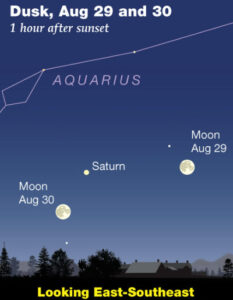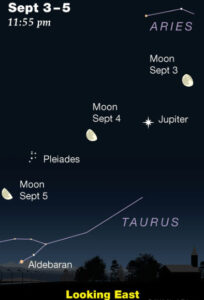Special to CosmicTribune.com, August 27, 2023, 2023
Excerpts from weekly Sky&Telescope report.
MONDAY, AUGUST 28
■ Different people have an easier or harder time seeing star colors, especially subtle ones. To me, the tints of bright stars stand out a little better in a sky that’s the deep blue of late twilight.
For instance, the two brightest stars of summer are Vega, nearly overhead at dusk, and Arcturus shining in the west. Vega is white with just a touch of blue. Arcturus is pale yellow-orange. Vega is a white-hot, type-A star. Arcturus is a less hot, type-K giant.
 TUESDAY, AUGUST 29
TUESDAY, AUGUST 29
■ After the Sun sets in the west-northwest, turn around and look on the opposite side of the sky for the low Moon, just a day from full. As the sky dims and the Moon climbs higher, how soon tonight can you see Saturn coming into view to its left. Both Saturn and the full Moon are about at opposition, so they shine together on full Moon night.
WEDNESDAY, AUGUST 30
■ Full Moon (exactly so at 9:36 p.m. EDT). Writes Gianluca Masi, “The 31 August full Moon will be the third supermoon of 2023, but it will be the largest of the year. In addition, being the second full Moon of this month, it is also a so-called blue moon. Having two supermoons in the same month is relatively rare: last time was in 2018, next time will be in 2037.”
Saturn accompanies the Moon across the sky tonight. Saturn seems to swing from upper right of the Moon at dusk, as shown, to directly right of the Moon by about 1 a.m., then lower right of the Moon as the hours approach dawn.
THURSDAY, AUGUST 31
■ A winter preview. Step out before the first light of dawn begins this week (about two hours before sunrise), and the sky displays the same starry panorama it does at dinnertime around New Year’s. Orion is striding up in the east-southeast, with Aldebaran and then the Pleiades above it.
FRIDAY, SEPTEMBER 1
■ Just after twilight fades away, look for bright Vega passing near the zenith (if you live in the world’s mid-northern latitudes). Vega goes right through your zenith if you’re at latitude 39° north: near Baltimore, Kansas City, Lake Tahoe, Sendai, Beijing, Athens, Lisbon.
■ As dawn brightens, catch Venus now rapidly emerging in the east from its conjunction with the Sun. In a telescope or even good binoculars it’s a thin crescent, just 11% sunlit. Venus is fast emerging as the Morning Star low in the eastern dawn. Procyon can’t compete.
 SATURDAY, SEPTEMBER 2
SATURDAY, SEPTEMBER 2
■ The two brightest stars of September evenings are Vega high overhead and Arcturus in the west, both magnitude 0.
Draw a line from Vega down to Arcturus. A third of the way down you cross the dim Keystone of Hercules. Two thirds of the way you cross the dim semicircle of Corona Borealis displaying its one modestly bright star: Alphecca, the gem of the crown.
SUNDAY, SEPTEMBER 3
■ A late-night telescope session tonight offers the Moon in its interesting waning gibbous phase, with lunar landforms near the terminator casting their shadows in the opposite direction from when the Moon is a thick waxing crescent seen in early evening.
Then switch to Jupiter shining right nearby, as shown below. Jupiter’s four bright Galilean moons are very roughly the size of our own Moon, but at 1,800 times the distance, they appear in a telescope as hardly more than pinpoints. Jupiter’s Great Red Spot should transit the planet’s central meridian tonight around 1 a.m. EDT.
Jupiter (magnitude –2.6, in Aries) rises about an hour after full dark. Watch for it to come up low in the east-northeast. Jupiter shines highest in the south just before the beginning of dawn.

You must be logged in to post a comment Login